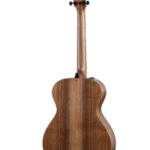Bass Guitar Tabs are a fantastic way for bassists to learn and play music, offering a visual representation of the fretboard. However, sometimes tabs can appear without stems, which are the vertical lines attached to the notes, indicating rhythm and timing. If you’re using Sibelius and struggling to display stems on your bass guitar tabs, you’re not alone! Many users encounter this when they want a more traditional notation style that includes rhythmic information alongside tablature.
This guide will walk you through the steps to make stems visible on your bass guitar tabs in Sibelius, ensuring your tabs are not only accurate for pitch but also clear in their rhythmic notation. Whether you prefer stems connected by beams or individual flagged stems, Sibelius offers the flexibility to display your tabs exactly how you need them.
Enabling Stems on Bass Guitar Tabs: A Step-by-Step Guide
To display stems on your bass guitar tabs in Sibelius, you need to adjust the instrument settings. Here’s how to do it:
-
Select a Measure: Begin by highlighting any measure within your 4-string bass tab staff in Sibelius. This tells Sibelius which instrument you want to modify.
-
Access Edit Instruments: Navigate to the “Home” tab in the Sibelius ribbon. Within the “Instruments” group, locate and click the small arrow at the bottom right corner. This action will open the “Edit Instruments” window.
-
Find Bass Guitar Instrument: In the “Edit Instruments” window, browse through the instrument families. Go to “Rock and Pop Instruments” and then select “Bass Guitar”. From the Bass Guitar options, choose “4-string Bass Guitar [tab]”.
-
Edit Instrument Settings: With “4-string Bass Guitar [tab]” selected, click the “Edit Instrument” button. A prompt message may appear asking if you want to edit the instrument. Click “Yes” to proceed.
-
Edit Staff Type: In the new window that appears, locate and click the “Edit Staff Type…” button. This opens the “Edit Staff Type” window where you can customize the notation display.
-
Navigate to Notes and Rests Tab: Within the “Edit Staff Type” window, click on the “Notes and Rests” tab. This section controls how notes and rests are displayed on the staff.
-
Enable Rhythms: Under the “Notes and Rests” tab, you will see a “Rhythms” option. Tick the checkbox next to “Rhythms” to enable the display of stems and rhythmic notation on your bass guitar tab.
-
Confirm Changes: Click “Ok” on the “Edit Staff Type” window, and then click “Close” on the “Edit Instrument” window to apply the changes.
After completing these steps, Sibelius should automatically display stems on your bass guitar tabs. Initially, you might see unconnected stems, which is a common default.
Grouping Stems with Beams for Connected Notation (Optional)
If you prefer to have stems connected with beams, especially for eighth notes or sixteenth notes, Sibelius allows you to group them. Here’s how to achieve connected stems, similar to standard music notation:
-
Select the Bar: Highlight the entire bar in your bass tab that you want to modify for beam grouping.
-
Access Beam Groups: Go to the “Appearance” tab in the Sibelius ribbon. Find the “Beam Groups” option and open its settings.
-
Adjust Beam Grouping: In the “Beam Groups” settings, you’ll likely see a default value like “4,4” for grouping eighth notes. To group eighth notes in pairs (common in many styles of music), change the value to “2,2,2,2” in the “Group 8ths (quavers) as” field.
By adjusting the beam groups, you can customize how stems are connected, creating a visually clearer rhythmic representation in your bass guitar tabs.
Why Display Stems on Bass Guitar Tabs?
While bass guitar tabs primarily focus on fret and string numbers, incorporating stems offers significant benefits:
- Rhythmic Clarity: Stems, along with beams and flags, visually represent the duration and timing of notes. This is crucial for understanding the rhythm and groove of a piece of music.
- Improved Reading: For musicians accustomed to standard notation, stems make tabs easier to read rhythmically, bridging the gap between tabs and traditional sheet music.
- Educational Value: Stems are essential for teaching and learning rhythm. Including them in bass tabs helps students develop a better sense of timing and musical phrasing.
Conclusion
Displaying stems on bass guitar tabs in Sibelius enhances the readability and musicality of your transcriptions. By following these simple steps, you can customize your bass tabs to include rhythmic notation, making them more informative and user-friendly. Experiment with both flagged and beamed stem styles to find what best suits your needs and the style of music you are working with. With stems enabled, your bass guitar tabs will be clearer, more expressive, and rhythmically accurate.

